The Soviet period
The first stage of the soviet epoch’s Azerbaijani architecture is more conspicuous in the workers’ settlements laid around Baku in Binegedi (now M. A. Rasulzade), Razin (now A. Bakhikhanov), Montin (now N. Narimanov district).
At this period a good deal of dwelling and cultural buildings were constructed in the historical center of the city and especially in suburbs in the place of old habitations. And if in the city’s suburbs the houses mainly consisted of the so-called “cottages” (small houses), in the center of the city they consisted of three or four-story buildings with long rows of “ribbon” windows and deep apertures of loggias.
Not only in the suburbs, but also in the historical center of the city and adjoining places there were built dwelling houses, administrative buildings and buildings of social nature, especially clubs and cultural centers in the “constructivism” style.
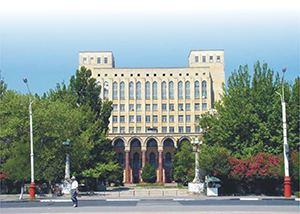
In 1926, electric railway line linking oil regions of Baku with city center was inaugurated and it was the first electric railway line in USSR. The construction complex, built along the road, was very attractive from the architectural point of view. The building of Sabunchu station (architect N. G. Bayev), which constructed at that time, is one of the perfect examples of them.
The most important work was the development of the General Plan of Baku, conducted by leading town-planners of the Soviet. Within a very short period of time, from 1924 to 1937, three versions of the General Plan of the city were worked out.
The first version, fulfilled under the supervision of architect A. Ivanitsky, assisted by A. and V. Vesnin brothers was very valuable because the authors took into consideration the relief and natural peculiarities of the territory, allowing working out a number of town-planning standards for Baku.
The second version worked out by a group of architects led from Moscow by V. Semenov laid the principles of settling the population within the entire territory of the Absheron Peninsula and suggested the creation of compact residential settlements, a prototype of small satellite cities built later around Baku.
The third version elaborated by a group of architects from Leningrad under the supervision of professor I. Ilyin, was the most logical of the three because of its compositional decision and town-planning merits. Creation of the city’s center inside of a semi-bowl amphitheater, architectural organizationof its coastal part, as well as consolidation of its main – lines directed to the center and located in the coastal part, was correctly outlined for the first time in the version.

There was not an organized central part of the city for ceremonial mass demonstrations, an integral part of the Soviet life, in those years in Baku. For this purpose a competition for the Project of the Palace of Soviets in Baku was announced. The first place in the competition was taken by the creative group of architects headed by L. Rudnev, E. Munz and K. Tkachenko. Later that project became a basis for the building of the Government House of the Republic, which was the realized in the 50s.
A good deal of attention was paid to planting trees and creation of gardens in Baku in those years. Gardens and parks were laid both in the historical part of the city and its new districts, with thousands of inhabitants of Baku participating in numerous voluntary unpaid work on Saturdays. But the most significant of those was laying out of the Park of Culture and Entertainment named after S. Kirov (now the historical-memorial complex “Shahidlar Khiyabani”) on the upper part of the Baku amphitheater, in the place of the old city cemetery. Beacuse of the landslide danger this part of the city was ineligible for any construction, that’s why a spacious park of terrace park, under supervision of professor A. Ilyin was projected here, which later became the favorite place fot the entertainment of the inhabitants of Baku. Now this is the holiest place for every Azerbaijani because the innocent martyrs of the tragic days of January 1990 and also those killed in the war with the Armenian invaders were buried here.
A remarkable event in the life of the republic in the 20s and 30s was the extensive training of highly qualified local construction engineers and architects – first in the Faculty of Architecture in the Azerbaijan Industrial Institute, then in the Azerbaijan Polytechnic Institute. Among the first garduate distinguished for their great talent and productivity were M. Useynov and S. Dadashov.
In 1944, the orgaization of the Architecture Departament under the Azerbaijan USSR Soviet of People’s Commissars stimulated the developmet of architectural sphere.
In 1945, the Institute of Art History was established within the Azerbaijan Academy of Sciences. Later called the Institute of Architecture and Arts had a great significance in the study of the theory and history of architecture in Azerbaijan since the most ancient times till today.
A small town Oil Rocks, the first open sea oil production site in the world, was founded in the post-war years.
The works of Azerbaijani architects were characterized by an adherence to the rich architectural heritage of Azerbaijan; they skillfully synthesized this heritage with main canons of the classic European architecture. Owing to the talent and skills of these architects, the center of Baku and its new districts were enriched with new, architecturally valuable and significant components from the point of view of town-building. These are the dwelling-houses of “Azneft” and “Buzovnaneft” trusts, “Actors’ House”, “Scientists’ House”, the building of the public library named after M. F. Akhundov and others. On the 50s-60s, architects also laid the main compositional junctions of Neftchilar Avenue which played a significant role in the formation of the new sight of the sea – side facade of the city, completed the architectural ensemble of Nizami square. The building of the Azerbaijan State Drama Theater and Fuzuli square were also formed.
The next General Plan of the city was worked out for the period till 1976, which was approved by the resolution of the Soviet of Ministers of the Republic in 1958.
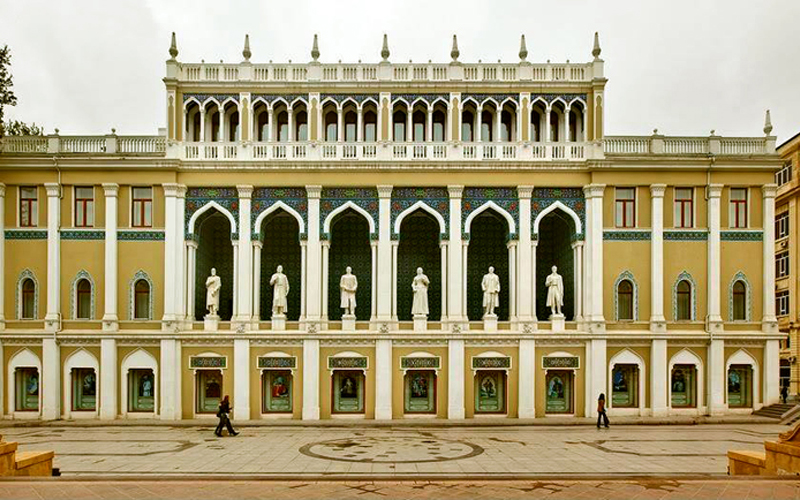
The buildings of the Ministry of Internal Affairs of Azerbaijan Republic and Baku branch of the Central Museum after V. I. Lenin - current Independence Museum (1954;1955; H. Majidov), the Republic Library after M. F. Akhundov (1960, M. Useynov), the Azerbaijan State Academic National Drama Theatre (1960, G. Alizade, with participation of M. Medetov), The Central Department Store (1961, N. Kangarli) and others , which built in 50s-60s enriched the architectural view of Baku. At those years, the medieval walls of the Icherisheher in the part of the Youth Square and Sabir Garden were restored and reconstructed; the Nizami monument and park (1949, sculptor F. Abdurrehmanov, architects S. Dadashov and M. Useynov), Nizami Museum of Azerbaijan Literature and Presidium of Azerbaijan National Academy of Sciences became an architectural panorama of Baku.
The construction of dwelling buildings by a contemptuous nick-name “khrushshovka” brought to featureless and dull masses. Not only the quality of architectural projects, but also the quality of constructions works were lowered. The architects started to use new concepts as “micro region”, “residential district”, “building complexes”, etc.
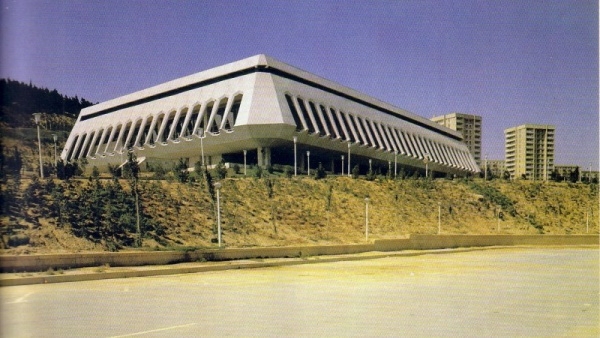
From end of 60s till the beginning of 80s, the work on dwelling and cultural construction, as well as on developing of engineering and transport systems, planting of tress and gardens, improvement of the city’s life was conducted in Baku intensively. The new residential district, Kilometer 8 grew in the south-east of the Baku amphitheater. Two new microregions, Ahmadli and Gunsehli, appeared in Ahmadli Plato and in districts attached to it, near Zig and Hovsan.
Together with an intensive development of new territoriesof the city, construction works were also conducted in the historical center of the city. The opening in 1967 of the Metro in Baku, the first in the Transcaucasia, was an important event in the life of the Republic. Designinng and construction of it started before the War.
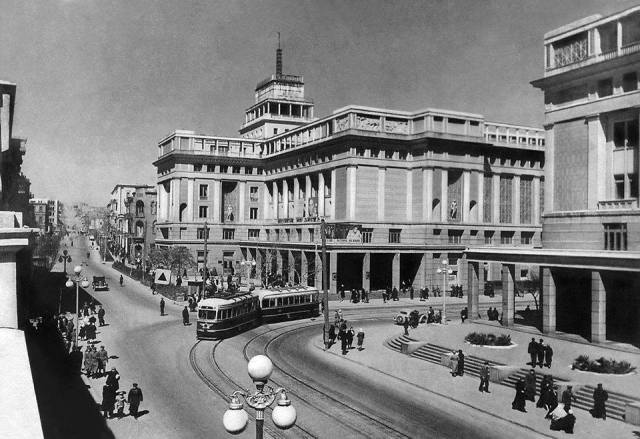
During the end of 60s and the beginning of 80s, gigant public buildings were constructed in Baku. The buildings of the State Circus (A. Ismayilov, F. Leontyeva), Heydar Aliyev Palace (V. Shulgin, B. Ginzburg, engineer K. Kerimov), “Gulustan” Palace (H. Emirkhanov, N. Hajibeyov, T. Sharinski, F. Rustembeyova, N. Ismayilov, K. Kerimov, 1982), the first building of “Oriental bazaar” (“Sharg bazari”) trade center (U. Revazov, P. Yarinovski), Hand Games Palace (F. Yuzabashov), Olympic Society (Z. Guliyeva), Presidential Palace of Azerbaijan Republic (T. Abdullayev) beautified the architectual view of the city. Some gigant public constructions, such as Heydar Aliyev Sports and Concert Complex (T. Abdullayev, O. Isayev, Y. Gadimov, T. Khanlarov) and the last building of “Oriental bazaar” (“Sharg bazari”) trade center (U. Revazov, P. Yarinovski) attracted from the point of view of town-building.
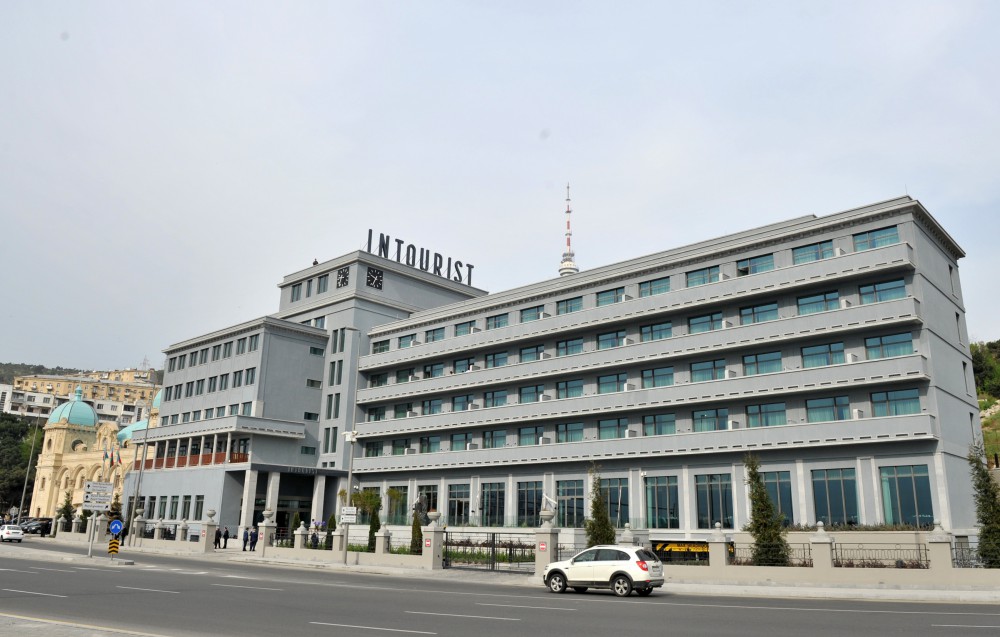
From 70s of the XX century, a serius of works were realized in planting of trees and gardens in Baku: park in front of the Heydar Aliyev Palace (F. Rustembeyova, A. Rustemzade, G. Mehdiyeva, 1973) and a fountain with cascading waterfall in a garden in front of the Cabinet of Ministers of Azerbaijan Republic in Lermantov street.
The General Plan of Baku for the period till 2000 was worked out by a group of architects from the Baku Project Institute in 1982. According to the amended General Plan the territory of the city had to grow considerably, its functional zone had to be perfected by the beginning of the third millennium. The architects continued their work on the development of the Draft Project of regenerationof the historical part of Baku, as well as the General Plan for preservation of the Baku Castle-“Icherisheher” for the development of tourism, as well as the propaganda of the culture and traditions of Azerbaijan.
From the end of 60s till the beginning of 80s Baku became one of the biggest industrial and cultural centers of the former USSR.
References used:
Dadashova S., Gasimzade E., Mammadov G., Baku - the pages of the history. Union of Architects of Azerbaijan Republic. Added and updated second edition. - Baku: Sharg-Garb, 2013. (in the azerbaijani language)
Azerbaijan National Encyclopedia. The third volume. Baku: The Azerbaijan National Encyclopedia Scientific Center, 2011, “Baku” article. (in the azerbaijani language)
Azerbaijan National Encyclopedia. Azerbaijan. Baku: The Azerbaijan National Encyclopedia Scientific Center, 2007, “Architecture” article. (in the azerbaijani language)
